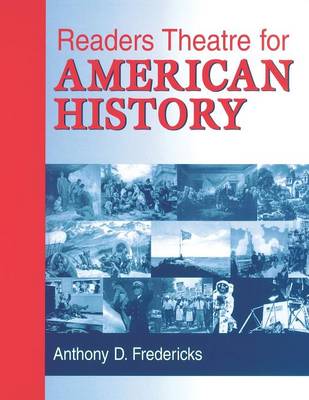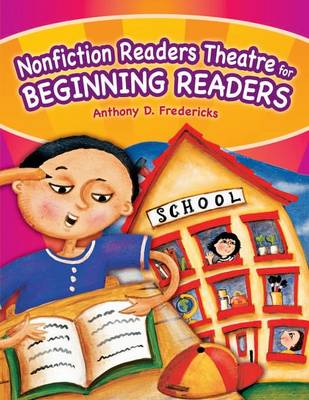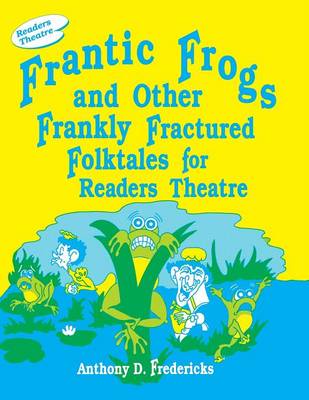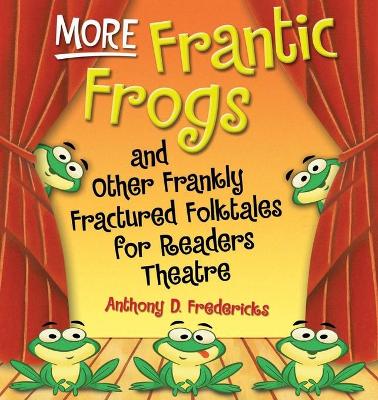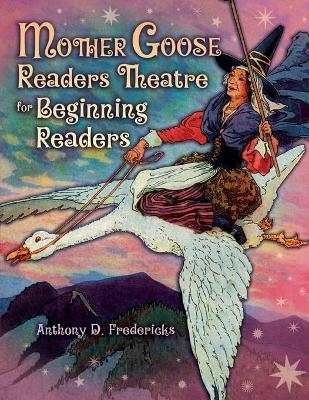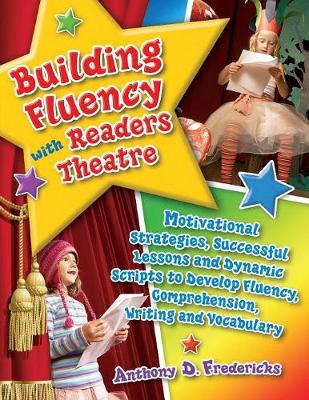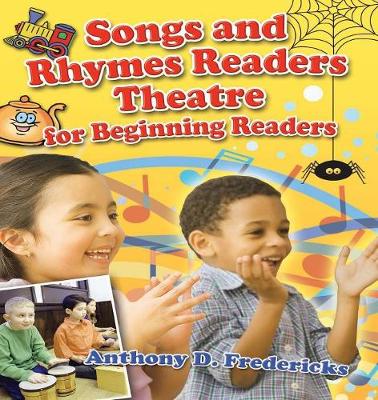Readers Theatre
11 total works
This participatory approach actively engages students in their own American history education. Arranged chronologically, these 24 readers theatre scripts put students in roles of selected historical figures, giving them a you are there perspective on the unfolding of critical milestones, memorable circumstances, and colorful venues that have shaped the American experience. Students can travel with a determined family along the Oregon Trail or to the moon with Neil Armstrong. Other opportunities to make history come alive include scripts having students work alongside Father Junipero Serra at Mission San Juan Capistrano and stand alongside Thomas Jefferson as he drafts the Declaration of Independence. Activity ideas and learning extensions follow each script.
Fill your classroom or library with imagination and excitement with this latest readers theatre offering from best-selling author Anthony D. Fredericks. The participatory approach in combination with some of the most creative and far-flung scripts in the universe will have your students actively engaged in scientific principles and possibilities. The 20 scripts in this fantastical resource will put your students in the roles of explorers, discoverers, scientists, and, yes-a few aliens, too. Students will be able to let their creativity take flight with this perfect addition to the language arts and science curriculum, as well as your library programming. Students will discover a mysterious object on the planet Pluto, observe aliens landing on a strange world and discover that some people are not what they seem to be. Packed with activity ideas and learning extensions, this resource is guaranteed to be a hit with your kids!
American Folklore, Legends, and Tall Tales for Readers Theatre
by Anthony D Fredericks
Tony Fredericks presents a collection of best loved stories in the popular readers theatre format to integrate with the United States history and language arts curriculum in the upper elementary and middle school grades. This collection of over 20 well-known and not-so-well-known tales will be invaluable to teachers in American schools as they do their usual units of study in American history and literature. Plays focus on entertaining folklore, tall tales, and legends to aid teachers in building fluency skills in their young readers. Included are tips for introducing and using Readers Theatre with students in grades 4-8.
Silly Salamanders and Other Slightly Stupid Stuff for Readers Theatre
by Anthony D Fredericks
Fill your library or classroom with giggles and laughter with these uproarious readers theater scripts from popular author Tony Fredericks. The more than two dozen reproducible scripts are based on fractured fairy tales and twisted legends. Guaranteed to re-energize the language arts and writing curricula, this collection will educate and entertain. The book also includes helpful guidelines and an abundance of tips and ideas for using readers theater to extend learning.
Teachers and librarians are continually looking for an interesting, fun way to input content knowledge to build that background information which will help push up student expository reading scores. Nonfiction readers theatre is one way to accomplish this. Professor Fredericks offers 30 short nonfiction readers theatre plays for the young reader (grades 1-3) on topics ranging from earth and natural science to community helpers, holidays, and government.
Test scores across the country show American students are far more able to read narrative than nonfiction text. Some research speculates this is due to a great lack in the background knowledge of many children. Librarians are beginning to realize that a unique fit for the school librarian is as a provider of background knowledge materials for teachers to use.
Frantic Frogs and Other Frankly Fractured Folktales for Readers Theatre
by Anthony D Fredericks
Have you heard Don't Kiss Sleeping Beauty, She's Got Really Bad Breath or The Ugly Duckling Sues His Parents for Bad Genes? This resource offers more than 20 reproducible satirical scripts for rip-roaring dramatics. Fredericks's side-splitting send-ups and wacky folktales and fairy tales are guaranteed to bring snickers, chuckles, and belly laughs into the classroom and get everyone involved. The book also contains guidelines and tips for using readers theatre in the classroom. It's a great icebreaker that everyone will enjoy! Grades 4-8.
More Frantic Frogs and Other Frankly Fractured Folktales for Readers Theatre
by Anthony D Fredericks
Tony Fredericks presents all-new scripts in this new book of fractured folk- and fairy tales for middle-grade readers theatre. Have you heard about The Boy Who Cried 'Amphibian' or about when Little Red Riding Hood punched that Big, Bad Wolf right in the mouth? Fredericks tells those stories and offers more than 25 additional reproducible, satirical scripts for rip-roaring dramatic reads. These scripts are guaranteed to evoke snickers, chuckles, and belly laughs, get everyone involved in production, and engage all audiences as well. The book also contains guidelines and tips for using readers theatre in the classroom to promote reading fluency and motivate young students to read! Grades 4-8.
Long-time successful Teacher Ideas Press author Tony Fredericks presents all-new scripts in this book of fractured folk- and fairy tales middle-grade readers theatre. Have you heard about The Boy Who Cried 'Amphibian' or the story about when Little Red Riding Hood punched that Big, Bad Wolf right in the mouth? Fredericks tells those stories and offers more than 25 additional reproducible, satirical scripts for rip-roaring dramatics. His side-splitting send-ups and wacky fractured folk and fairy tales are guaranteed to bring snickers, chuckles, and belly laughs into the classroom, get everyone involved in production, and engage all audiences as well. The book also contains guidelines and tips for using readers theatre in the classroom to promote reading fluency and motivate young students to read! Grades 4-8.
Written for children reading at first and second grade levels, this readers theatre book uses Mother Goose rhymes as its basis, making it especially valuable to teachers and librarians working on building fluency skills in their beginning readers. The book offers plays based on well-known rhymes, complete with presentation and instructional follow up suggestions. The author also offers staging diagrams that enable teachers to use each script with entire classrooms of students, and he includes lists of further teaching resources for each play as well. Reading levels are based on accepted readability formulas. Several of the scripts feature simultaneous Spanish translations-a real plus for ELL programs. An introductory chapter discusses the educational value of using readers theatre with young readers and ELL students. Grades 1 and 2.
This new title from well-known readers theatre author Tony Fredericks is designed to offer librarians and teachers specific information and detailed guidelines on how to begin (and continue) with readers theatre - specifically how it can be used to promote fluency. Practical information about how to advocate for the use of readers theatre as part of your weekly schedule is featured, as is what to tell your principal about using readers theatre.
Chapters include the theory and practice behind the use of reader's theatre to promote reading fluency and other language arts skills as well as practical advice in integrating readers theatre with the daily language arts instruction schedule, including model schedules to include guided reading, literature circles and other current instructional methodologies. Grades K-8.
This new title from well-known readers theatre author Tony Fredericks is designed to offer librarians and teachers specific information and detailed guidelines on how to begin (and continue) with readers theatre - specifically how it can be used to promote fluency and the five other Reading First principles. Practical information about how to advocate for the use of readers theatre as part of your weekly schedule is featured as is what to tell your principal about using readers theatre.
Chapters include the theory and practice behind the use of readers theatre to promote reading fluency and other language arts skills as well as practical advice in integrating readers theatre with the daily language arts instruction schedule, including model schedules to include guided reading, literature circles and other current instructional methodologies. Featuring lesson plans, model scripts, and information about how to adapt and write scripts for student use, this will be an invaluable tool for teachers beginning or trying to sustain the use of readers theatre in their classroom. Grades K-8.
Songs and Rhymes Readers Theatre for Beginning Readers
by Anthony D Fredericks
Kids love music and rhymes; literacy often begins that way. Singing nursery and other rhymes, pairing the song with books is a proven way to begin reading instruction and it is fun! Primary teachers and their librarians love to play rhyming and singing games often accompanied by hand and body motions. Out of requests from teachers and librarians attending his workshops, Tony Fredericks presents this readers theatre book for young readers, grades 1-2, built on the songs and rhymes that they already love and know. Scripts built around such rhymes and songs as: The Itsy, Bitsy Spider, The Farmer in the Dell, Hush, Little Baby, If You're Happy and You Know It, and I'm a Little Teapot will encourage kids to read the scripts, all the while building reading fluency. As in Fredericks' other books for the beginning reader, this book furnishes presentation suggestions, rationale for using readers theatre, and readability information, as well as ideas for movement and dance. Grades 1-2.
